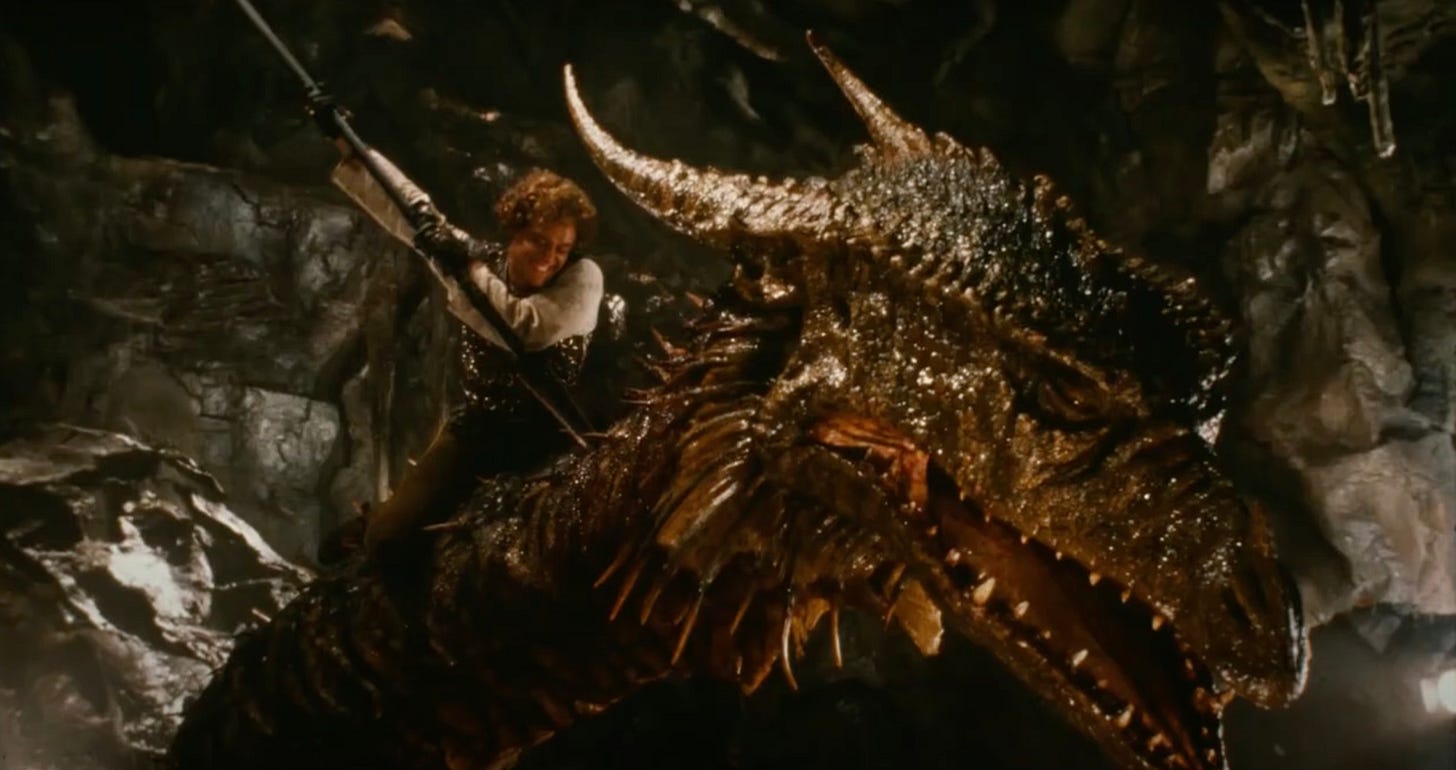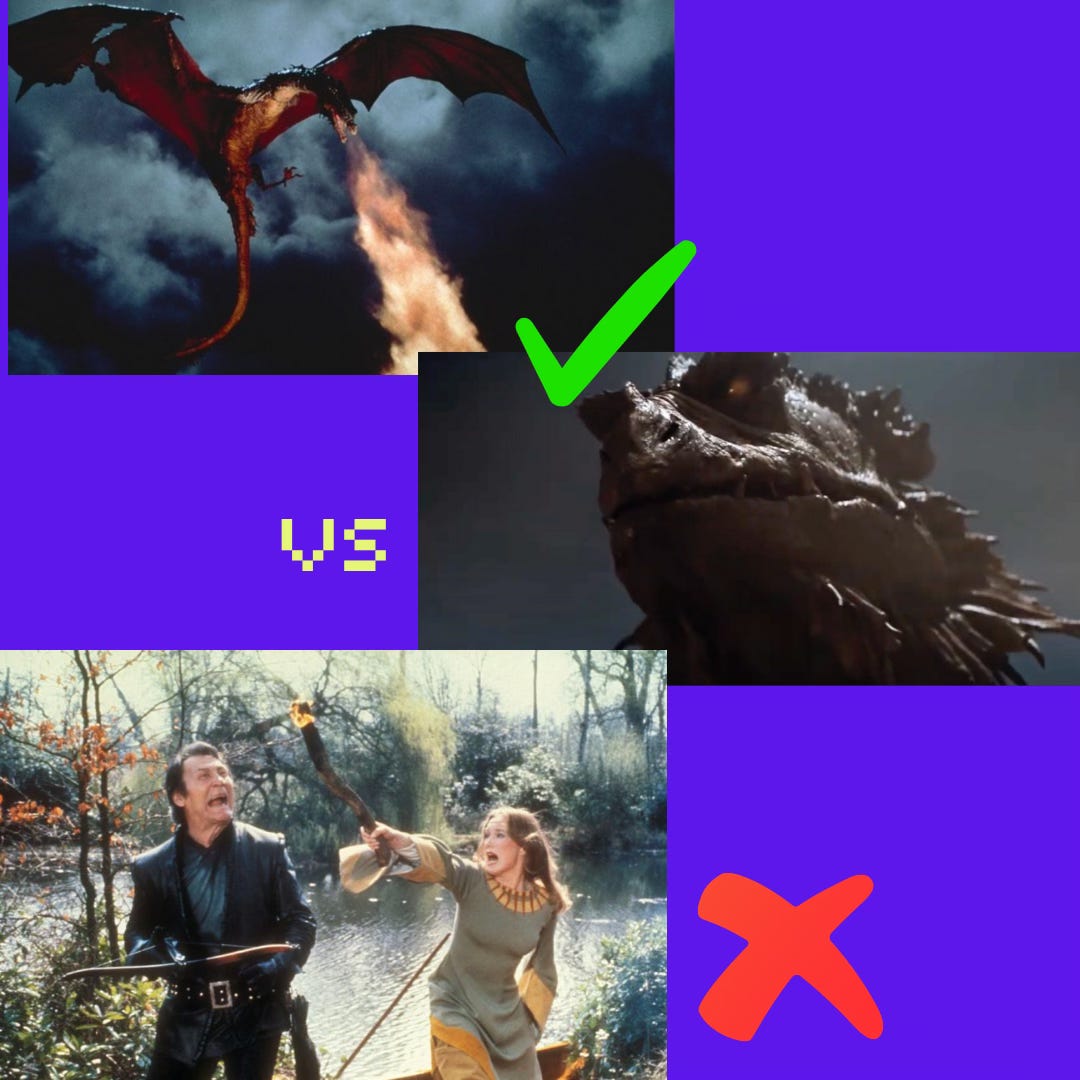Another day, another 1980s sword and sorcery film — but Matthew Robbins’ box office flop Dragonslayer (1981) stands out for its groundbreaking special effects, and for its sense of missed opportunity. In an interview, Robbins relates that during previews George Lucas leaned over to him and whispered: “You’ve got a hit!”1 So what went wrong?
Tolkien + ILM = Dragonslayer
Dragonslayer’s origin story eerily resembles that of Hawk the Slayer: two friends and collaborators, Matthew Robbins and Hal Barwood, sat down to write a screenplay. They believed that audiences would flock to a summer blockbuster set in a Tolkienian world but using techniques pioneered by their friend George Lucas at Industrial Light & Magic.
Dragonslayer was picked up by Disney and Paramount, eager to capitalize on the popularity of Dungeons & Dragons. It was the second in a two-film collaboration between the two studios; the other was the truly bizarre Popeye (1980). Dragonslayer was released in theaters on July 26, 1981, incidentally just ahead of another ILM masterpiece: Raiders of the Lost Ark. It was well reviewed by critics, drawing favorable comparisons to Star Wars. Alex North’s Prokofiev-inspired original score and ILM’s stunning effects work on the dragon were singled out for praise, garnering Academy Award nominations (both of which ultimately went to Raiders instead).
But Dragonslayer bombed at the box office, netting about $14.1 million worldwide against its $18 million budget. Why didn’t it catch on? Dragonslayer is indeed dark in tone for Disney (again, severed foot!), and this may be part of the problem for audiences expecting something more on brand. In a short advance notice in Cinefantastique Paul M. Sammon suggested that filmmakers were shooting for an R rating (though they eventually landed on PG) because of nudity and “hard core violence,” both of which made it into the final cut.2 But I think a more fundamental reason Dragonslayer sat uneasily with audiences is its earnest engagement with its medieval hagiographical source material: the legend of St. George and the dragon.
Enter the Dragon
As the wide collection of texts in Scott G. Bruce’s Penguin Book of Dragons attests, dragons appear in texts and stories from the ancient world to the present, but their meaning varies across time and culture.3 While Robbins and Barwood may not have had a specific text in mind, their dragon draws heavily from the legend of one figure in particular: St. George.
According to Greek texts, St. George of Lydda was born into a noble Christian family in Cappadocia during the late third century CE. He joined the Roman army, but was martyred, possibly in 303 CE during the Emperor Diocletian’s crackdown on Christians in his ranks. George was venerated as a megalomartyr, especially in the Eastern church, throughout the earlier middle ages. Dragon slaying was a later addition to his legend, originating in Eastern Europe and making its way into western sources by the 12th century.4 In this tale, a dragon threatens the city of Silene in Libya, and in order to appease it the king and his people feed it one sheep and one young person each day. George comes upon the city’s princess, who has been chosen by lot for sacrifice, and saves her by subduing the dragon, thereby saving the town.
The story clearly derives from classical models like Perseus and Andromeda or Heracles and Hesione, but with a Christian twist. As many scholars have pointed out, in later medieval hagiography the dragon represents the pagan ignorance of the population it threatens.5 Hagiographical dragon slaying, then, is usually accompanied by mass conversion to Christianity. In the legend, George has the freshly rescued princess use her girdle to lead the wounded dragon “as meekly as a puppy” back into town, where he tells the terrified townspeople:
“Do not be afraid…The Lord has sent me to free you from the tyranny of the dragon. Only believe in Christ and be baptized, every one of you, and I will slay your dragon!”6
Which sounds a lot like blackmail, actually?
Dragonslayer rather astonishingly does engage with this source material by integrating a Christian subplot. Unfortunately this is the least successful part of the film. The monk Brother Jacopus (Ian McDiarmid) bravely but unsuccessfully confronts the dragon before getting incinerated. Valerian’s father (Emrys James) gives her a cross pendant as she goes off with Galen to slay the dragon, telling her “It can’t hurt.” Later, during Ulrich’s climactic battle with Vermithrax, the townspeople frantically embrace baptism as a way to fend off the dragon, though what defeats it in the end is Ulrich’s sacrifice. There’s no apparent connection between the made-for-summer-blockbuster events surrounding the dragon and the townspeople’s miserable scramble for survival, no sense of what they believe now or why the dragon is tormenting them in particular. The use of medieval source material showed promise and vision, but in the end just takes up unnecessary space.
Industrial Light & Dragons
Really, though, I think the problem is that the filmmakers were in love with this dragon, and understandably so. Vermithrax is both genuinely beautiful and, thanks to clever camera and effects work, scary in a still-resonant way. Guillermo del Toro and George R.R. Martin have both sung Vermithrax’s praises, and Game of Thrones’ dragons bear more than a passing resemblance to Vermithrax in their bat-like wings and crawl-stomp movement on the ground (season 1 episode 4 of GoT lists Vermithrax with Targaryen dragons past). ILM’s Phil Tippett used the go-motion technique he pioneered for Star Wars Episode V: The Empire Strikes Back (1980) to make the dragon’s movements look more realistic, and filmmakers used 16 puppets in various sizes, including a forty-foot hydraulic model. The result was what one reviewer called “a beast just short of exhibiting a personality.”7
The dragon does not appear in full until nearly halfway through the film. Before that, we get a sense of size and menace built solely on fleeting glimpses of the dragon: a claw or a tail as Vermithrax toys with a sacrificial virgin; the partially obscured head that looms up in front of Brother Jacopus before incinerating him. When Valerian (Caitlin Clarke) brings scales as evidence of the dragon to the wizard Ulrich (Ralph Richardson) at the beginning of the film she misidentifies a tooth as a claw before he corrects her. It’s an effective way to build suspense, and underscores that no one knows what the dragon looks like because no one has yet lived to tell the tale.
For all the terror, the filmmakers also went out of their way to give Vermithrax some inner life, as well. A super-detailed hand puppet was used to capture subtle facial movement and expression, for example in the scene where Vermithrax encounters the dead dragonets and expresses something like sorrow. Ulrich’s speech early in the film draws a line of kinship between the elderly wizard and the equally elderly Vermithrax:
“If it weren’t for sorcerers there wouldn’t be any dragons. Once the skies were dotted with them…When a dragon gets this old, it knows nothing but pain, constant pain. It grows decrepit, crippled, pitiful. Spiteful.”
They are both the last of their kind, old and in pain; and they are destined to die together to make way for a new world. It reminded me a bit of Excalibur, and Merlin’s poignant speech on how magic is fading away. Unlike Excalibur, though, which promises a return someday, Dragonslayer does not convince me that whatever new world is coming will be worth what was lost.
But without further adieu, here is where Dragonslayer stands in our Sword & Sorcery bracket:
Sword & Sorcery Bracket: Hawk vs. Dragonslayer
What Happens: Sorcerer’s apprentice Galen confronts the dragon Vermithrax Pejorative, as well as his own immaturity, with the help of his occasionally dead mentor and new girlfriend. As the king (Peter Eyre) selectively sacrifices virgin girls to the dragon and the townsfolk toy with converting to Christianity, the dragon chews scenery and crew alike and stands in for the uncontrollable and mysterious forces of magic.
Protagonists | Winner: Dragonslayer
This was an easy call. As heroes go, the overconfident but lovable Galen easily bests the wooden Hawk. According to Robbins, Disney pressured him to cast American leads amidst the British setting. Wholesome-looking Minnesotan MacNicol fit the bill, and was an accomplished horseman into the bargain. The versatile heroine Valerian has blacksmith skills from working in her father’s shop; makes a super useful fireproof shield out of dragon scales; provides crucial intel about the existence of dragonets; and drags Galen’s hapless, singed ass out of the cave after his first fruitless attempt. Pittsburgh native Caitlin Clarke brings a delightful earthy crankiness to her lines with Galen that I’m absolutely here for. Hawk was mentor-less (which was honestly the least of his problems) but Ralph Richardson as Ulrich manages to be mysterious, crotchety, and warm all at once: an ideal wizard. 1981 was a big year for him — he also played God in Time Bandits (review coming).
Antagonists | Winner: Dragonslayer
A marginally tougher call, but only because of how much I love Jack Palance in Hawk. If he had to lose, it had to be to a magnificent and terrifying, and yet also emotionally layered, beast like Vermithrax. Secondary villains in Dragonslayer include the underutilized warrior Tyrian (John Hallam; Galen has to have a sword fight with someone I guess) and the corrupt Casiodorus Rex. Eyre’s Casiodorus is venal and vague at the same time, yet still stirs sympathy when his daughter, Princess Elspeth (Chloe Salaman), rigs the lottery to ensure she is chosen for sacrifice. Spoiler: it’s her foot.
Other Extenuating/ Aggravating Circumstances | Winner: Dragonslayer
Even though I’d argue that Dragonslayer has some serious pacing and tonal problems (was this for kids? adults? I honestly can’t tell) it is the clear winner. Quite apart from ILM’s masterful work on the dragon, the filmmakers’ feat of world building is a resounding success, from the lush forest (filmed at Pinewood Studios in London) to the craggy Welsh and Scottish peaks to the steamy claustrophobia of Vermithrax’s lair (again, Pinewood). My nerd’s heart also thrilled to all the Latin, which for me was close captioned [speaking foreign language] — both Richardson and MacNicol deliver quite a lot of their magic lines in Latin, and while I didn’t catch everything some of it seemed pretty accurate! Not for nothing, Robbins was a Romance Languages major at Johns Hopkins before going to film school at USC, and the film’s credits list a Latin consultant (#career goals).
Overall Winner: Dragonslayer (1980)
Dragonslayer thus easily topples Hawk from the top spot, thank goodness, and wins a moment in the sun as a very un-Disney Disney movie. In the words of Cinefantastique’s reviewer David Bartholomew:
“It’s our good fortune…that the story has not been rendered into puerile Disney juvenilia. Dragonslayer is no simple-minded family frolic — it is a tough, adult movie which works like some great trashing satire of a Disney movie.”8
Severed foot of a princess and all.
Dragonslayer 1981: Making of & Behind the Scenes. If not otherwise cited production info comes from this special feature video.
Paul M. Sammon, “Disney/ Paramount join forces, combine talents to film Dragonslayer,” Cinefantastique 10.1 (1980): 32.
Scott G. Bruce, ed. The Penguin Book of Dragons (Penguin, 2021).
On the evolution of the George legend, see especially Samantha Riches, St. George: Hero, Martyr, Myth (Sutton, 2000); Daniel Ogden, The Dragon in the West: From Ancient Myth to Modern Legend (Oxford, 2021), pp. 296-302; C. Walter, “The Origins of the Cult of St. George,” Revue des études byzantines 53 (1995): 295-326.
Ogden, Dragon in the West, 169;
Quoted in Penguin Book of Dragons, p. 155.
David Bartholomew, “Here’s a fantasy with teeth, graced by magnificent special effects,” Cinefantastique 11.3 (1981): 46.
Bartholomew, 46.










I’m so glad I know this movie exists now. Must watch immediately!!